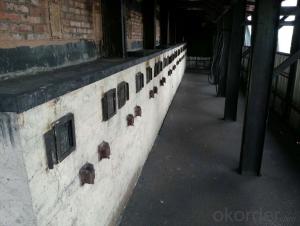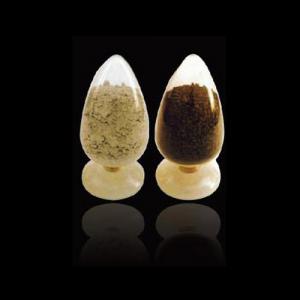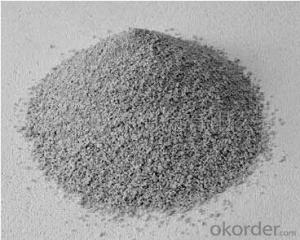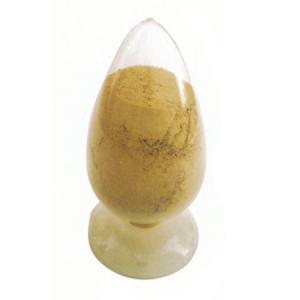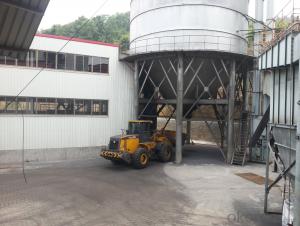Low Nitrogen Carbon Raiser Graphite Pitch Coke
- Loading Port:
- Shekou
- Payment Terms:
- TT OR LC
- Min Order Qty:
- 20 m.t
- Supply Capability:
- 1000 m.t/month
OKorder Service Pledge
OKorder Financial Service
You Might Also Like
Factory Background
The factory is majorly running and operating carbon additive (pitch coke, calcined petroleum coke and anthracite), low nitrogen carbon additive, and brake pad making material. Company is the long term supplier of Sinosteel Corporation, Shanghai Carbon Corporation, the plant of SGL Group the Carbon Company in China and some largest special carbon products producing plants.
YUAI also supplies huge amout of high quality carbon additive and graphite carbon additive to steel plants, foundries and ferrotungsten plants. YUAI has been assigned by BAO STEEL as the only organization for processing pitch coke for export purpose. The group’s major products are constantly exported to Japan, Korea, Malaysia, South East Asia countries, Europe and America, which receive praises by our consumers.
The group has invested numbers of calcinators in Anhui China to ensure the capability of producing and processing huge amount of carbon additive. Further investment is on process. According to the orders from customers, YUAI is able to processing and providing different specifications of carbon additive and other products. To provide best quality of products and to offer customers most satisfied service is YUAI’s operating objectives.
Calcined Petroleum Coke
FC:98.5%min,
S:0.5%max
A:0.8%max
V:0.7%max
Mositure:0.5%max
Size:1-5mm
This product is mainly used in steel-making and foundry. Calcined Petroleum Coke
Calcined Petroleum Coke comes from delayed coke which extracted from oil refinery. Although Calcined Petroleum Coke contains a little bit higher level of sulfur and nitrogen than pitch coke, the price advantage still makes it widely used during steel-making and founding as a kind of carbon additive/carburant.
Technology:
Laborary Equpment
In our lab,we has a high precision balance,mullfe furnace,sample making machine, dring box,sulfur measurement instrument and other calibratiing equipments.As a result,before deliverung to our customers,our products have to pass a strict test to ensure the quality and components.The testing reports will be sent to our customers to confirm untill they satisfy with it.
Packaging & Delivery
Packaging Detail:25kg paper bag into 1t weaving bag 5kg, 10kg and 20kg weaving bag into 1t weaving bag 25kg weaving bag put on pallet covered with entanglement wrap product direct into packing bag 25kg paper bag put on pallet covered with entanglement Wrap 25kg weaving bag into 1t weaving bag.
Delivery Details: 7 days


- Q:How do monolithic refractories improve the thermal efficiency of iron and steel furnaces?
- Monolithic refractories play a crucial role in improving the thermal efficiency of iron and steel furnaces. These refractories are essentially a single, solid mass that is used to line the furnaces and provide insulation and protection against the extreme temperatures generated during the metal production process. One way in which monolithic refractories enhance thermal efficiency is by reducing heat loss. These materials have low thermal conductivity, meaning they are poor conductors of heat. By lining the furnace with monolithic refractories, the heat generated inside the furnace is effectively contained within the chamber, minimizing heat loss to the surrounding environment. This allows for more efficient use of energy, as less heat is wasted and more of it is utilized for the intended purpose of heating and melting the metal. Additionally, monolithic refractories also contribute to the overall efficiency of the iron and steel furnaces by providing a high level of heat resistance. The extreme temperatures reached inside these furnaces can easily damage or deteriorate conventional refractory materials. However, monolithic refractories are designed to withstand these harsh conditions, maintaining their integrity and performance over extended periods. This durability ensures that the lining remains intact, preventing any potential leakage of heat and ensuring that the furnace operates at maximum efficiency. Furthermore, monolithic refractories offer flexibility in their installation process. They can be easily shaped and molded to fit the intricate designs and contours of the furnace, creating a seamless and continuous lining. This eliminates any gaps or weak points that could allow heat to escape or cold air to enter, further enhancing the thermal efficiency of the furnace. Overall, monolithic refractories significantly contribute to the thermal efficiency of iron and steel furnaces by reducing heat loss, providing high heat resistance, and ensuring a tight and continuous lining. By optimizing heat utilization and minimizing energy wastage, these refractories play a vital role in improving the productivity and sustainability of the iron and steel industry.
- Q:What are the factors to consider when selecting monolithic refractories for specific applications?
- When choosing monolithic refractories for specific applications, one must take into account several factors. These factors encompass the operating temperature, chemical environment, mechanical stress, and desired performance characteristics of the refractory material. The operating temperature plays a pivotal role and varies depending on the monolithic refractory. It is crucial to select a refractory material that can withstand the specific temperature range without experiencing thermal spalling or degradation. The chemical environment also plays a vital role. Different applications may expose the refractory to various chemicals, acids, alkalis, or gases. It is essential to choose a monolithic refractory that is chemically resistant to the specific environment to ensure durability and performance over time. Mechanical stress is another critical consideration. Certain applications may subject the refractory to high mechanical stress, such as abrasion, impact, or thermal shock. It is important to choose a refractory material that can withstand these stresses without cracking or failing. The desired performance characteristics of the refractory material should also be taken into account. This includes factors such as thermal conductivity, thermal expansion, density, and strength. The specific requirements of the application will dictate the necessary performance characteristics, and the refractory material should be chosen accordingly. Other factors to consider include the method of installation, availability, cost, and maintenance requirements. Some monolithic refractories may require specialized installation techniques, while others may be readily available and cost-effective. Additionally, the maintenance requirements of the refractory material should be considered to ensure ease of upkeep and longevity. In conclusion, selecting the appropriate monolithic refractories for specific applications necessitates careful consideration of factors such as operating temperature, chemical environment, mechanical stress, desired performance characteristics, installation method, availability, cost, and maintenance requirements. By taking these factors into account, one can choose a refractory material that will provide optimal performance and durability in the given application.
- Q:What are the advantages of using monolithic refractories in the iron and steel industry?
- Monolithic refractories offer several advantages in the iron and steel industry. Firstly, they provide excellent thermal insulation, helping to maintain high temperatures within the furnaces and kilns, ensuring efficient and consistent production processes. Secondly, monolithic refractories have high resistance to thermal shock and mechanical stress, making them durable and long-lasting in harsh operating conditions. Additionally, their ability to be easily shaped and installed reduces downtime during maintenance or repairs. Lastly, monolithic refractories have good chemical resistance, protecting against corrosive elements present in iron and steel production, thereby enhancing the overall performance and productivity of the industry.
- Q:How do monolithic refractories contribute to energy efficiency in iron and steel production?
- Enhancing energy efficiency in iron and steel production processes is a crucial role played by monolithic refractories. These refractories, which are unshaped materials, are utilized to line the components of furnaces, kilns, and other high-temperature equipment involved in the production of iron and steel. One method by which monolithic refractories contribute to energy efficiency is through their excellent insulation properties. These materials possess low thermal conductivity, effectively reducing heat transfer from the furnace or kiln to the surrounding environment. By minimizing heat loss, monolithic refractories aid in maintaining high temperatures within the production units, ultimately reducing the energy required to sustain the desired operating conditions. Moreover, monolithic refractories offer exceptional resistance to thermal shock and wear, ensuring the longevity of the lining materials. This durability diminishes the need for frequent repairs and replacements, resulting in less downtime and increased operational efficiency. Consequently, energy is conserved as the production units can continuously operate at optimal temperatures without interruptions. Additionally, monolithic refractories exhibit excellent resistance to chemical reactions, corrosion, and erosion caused by molten metals and slag. This resistance decreases the formation of cracks and defects in the lining, which can compromise the insulation and increase heat loss. By maintaining a robust and intact lining, monolithic refractories contribute to energy efficiency by minimizing heat escape and ensuring the efficient utilization of energy for the iron and steel production processes. Furthermore, the utilization of monolithic refractories allows for design flexibility in the construction of furnaces and kilns. Their ability to be shaped and applied in various configurations enables the creation of optimized lining structures that enhance heat transfer and combustion efficiency. This flexibility empowers engineers and operators to design and modify the production units to maximize energy efficiency and minimize energy wastage. In conclusion, monolithic refractories significantly contribute to energy efficiency in iron and steel production through their excellent insulation, durability, resistance to thermal and chemical degradation, and design flexibility. By reducing heat loss, minimizing repairs and replacements, and optimizing heat transfer, these refractories play a vital role in conserving energy and improving the overall sustainability of the iron and steel industry.
- Q:How do monolithic refractories withstand high temperatures in iron and steel processing?
- Monolithic refractories are able to withstand high temperatures in iron and steel processing due to their unique composition and properties. These refractories are primarily made of a single, continuous material, making them highly resistant to thermal shock and mechanical stress. Additionally, they have a high melting point and excellent heat insulation properties, allowing them to maintain their integrity even in extreme heat conditions. The refractories also possess good chemical stability, preventing reactions with molten metals and other corrosive substances often encountered in iron and steel processing facilities. Overall, the combination of these features enables monolithic refractories to endure the intense temperatures and harsh conditions involved in iron and steel processing.
- Q:How do monolithic refractories perform in electric arc furnace roof applications?
- Due to their unique properties and characteristics, monolithic refractories are extremely effective when used in electric arc furnace (EAF) roof applications. Comprised of a single, solid material, these refractories offer several advantages specific to this application. To begin with, monolithic refractories provide exceptional thermal insulation, a critical factor in EAF roof applications. Traditional brick refractories can suffer structural damage from the intense heat generated in the furnace. However, monolithic refractories possess a higher resistance to thermal shock, reducing the risk of cracking and spalling. This ensures that they maintain their integrity and insulation properties even under extreme temperature conditions. Furthermore, monolithic refractories exhibit high strength and abrasion resistance, guaranteeing their durability and longevity in EAF roof applications. The roof of an electric arc furnace is subjected to harsh conditions, including the impact of scrap materials and the erosive effects of molten metal and slag. Monolithic refractories are specifically designed to withstand these challenges, offering superior resistance to mechanical wear and erosion. Another advantage of monolithic refractories lies in their ease of installation. Unlike traditional brick refractories, which necessitate time-consuming and complex installation processes, monolithic refractories can be applied rapidly and efficiently. They can be cast, gunned, or sprayed onto the roof surface, adapting to any shape or contour. Consequently, installation or repair downtime is reduced significantly. Moreover, monolithic refractories contribute to increased energy efficiency in EAF roof applications. Their superior insulation properties minimize heat loss, resulting in reduced energy consumption and cost savings. This is particularly crucial for electric arc furnaces, as their efficiency and productivity heavily rely on maintaining high temperatures for metal melting and processing. Any heat loss can have a significant impact on these factors. In conclusion, monolithic refractories are highly suitable for electric arc furnace roof applications due to their exceptional thermal insulation, strength, abrasion resistance, ease of installation, and energy efficiency. These refractories offer significant advantages over traditional brick refractories, ensuring optimal performance and extended service life in the demanding environment of an electric arc furnace.
- Q:What are the common applications of monolithic refractories in blast furnaces?
- Monolithic refractories, also referred to as unshaped refractories, find extensive use in blast furnaces due to their advantageous properties and versatile applications. Blast furnaces benefit from the following common applications of monolithic refractories: 1. Furnace lining: The walls, hearth, and roof of blast furnaces are lined with monolithic refractories. These refractories possess high thermal resistance and excellent insulating properties, safeguarding the furnace structure against extreme temperatures and thermal shocks. 2. Repair of tuyeres and tapholes: Tuyeres are nozzles that introduce air or fuel into the furnace, while tapholes are openings used for tapping molten iron or slag. Monolithic refractories are employed to repair and maintain these crucial components, as they can endure the high temperatures and chemical reactions taking place in these regions. 3. Hot repair and maintenance: The demanding operating conditions of blast furnaces necessitate frequent repairs and maintenance. Monolithic refractories are utilized for hot repair and maintenance purposes, as they can be easily applied in a plastic or semi-plastic state to fill cracks, mend damaged areas, or replace worn-out linings. 4. Resistance to erosion and corrosion: Blast furnace environments are highly corrosive due to the presence of molten iron, slag, and other molten materials. Monolithic refractories with exceptional erosion and corrosion resistance protect the furnace lining against chemical attacks, extending its lifespan. 5. Gunning mixes: Gunning mixes are extensively employed in blast furnaces for their ability to be sprayed or gunned onto the refractory lining. These mixes comprise fine refractory aggregates, bonding agents, and additives. They are applied to repair worn-out areas, seal cracks, and provide a protective layer against erosion and slag penetration. 6. Repair of slag line and iron runners: The slag line and iron runners in blast furnaces are prone to erosion and wear due to the corrosive nature of molten slag and iron. Monolithic refractories are utilized to repair and reconstruct these areas, ensuring smooth and efficient furnace operation. To summarize, monolithic refractories play a vital role in blast furnaces, fulfilling numerous functions such as furnace lining, tuyere and taphole repair, hot repair and maintenance, erosion and corrosion resistance, gunning mixes, and repair of slag line and iron runners. Their ability to withstand high temperatures, chemical attacks, and mechanical stresses renders them indispensable in maintaining the integrity and efficiency of blast furnace operations.
- Q:How do monolithic refractories improve energy efficiency in the iron and steel industry?
- Various mechanisms are employed by monolithic refractories to enhance energy efficiency in the iron and steel industry. To begin with, these refractories possess exceptional insulation properties that effectively minimize heat loss during production. This results in a higher retention of heat within the furnace, thereby increasing energy efficiency. Furthermore, monolithic refractories exhibit low thermal conductivity, facilitating improved heat transfer within the furnace. This allows for efficient distribution of the heat generated during production, enabling optimal temperature control and reducing energy wastage. Additionally, monolithic refractories demonstrate high resistance to thermal shock and corrosion, which are common challenges faced in the iron and steel industry. By enduring extreme temperatures and chemical reactions, these refractories prevent premature wear and tear, consequently reducing the need for frequent repairs and replacements. This not only conserves energy but also minimizes downtime, leading to enhanced productivity and energy efficiency. Moreover, the utilization of monolithic refractories enables better furnace design and optimization. Their flexibility permits the creation of bespoke shapes and linings that cater to specific furnace requirements, resulting in improved heat transfer and combustion efficiency. This customized approach promotes energy savings by maximizing fuel utilization and reducing emissions. Lastly, monolithic refractories possess a longer lifespan compared to conventional brick refractories. This prolonged durability reduces the frequency of refractory replacements, subsequently lowering the energy consumption associated with the manufacturing and installation of new refractories. Overall, monolithic refractories play a significant role in enhancing energy efficiency in the iron and steel industry by reducing heat loss, improving heat transfer, withstanding thermal shock and corrosion, enabling better furnace design, and increasing refractory lifespan. Their usage not only saves energy but also enhances productivity and sustainability within the industry.
- Q:How do monolithic refractories impact the overall productivity of iron and steel operations?
- Monolithic refractories play a crucial role in enhancing the overall productivity of iron and steel operations. These refractories are specially designed to withstand extreme temperatures, chemical reactions, and mechanical stress that occur during the production process. One significant impact of monolithic refractories on productivity is their ability to reduce downtime and increase operational efficiency. The high thermal conductivity and resistance to thermal shock of these refractories enable them to maintain stable temperatures within the furnace, preventing sudden temperature fluctuations that can cause equipment failure and production delays. This, in turn, ensures a continuous and uninterrupted production process, leading to increased productivity. Moreover, monolithic refractories offer superior corrosion resistance, preventing the erosion and degradation of furnace linings. This resistance to chemical attacks from molten metals and slag helps prolong the lifespan of the refractory lining, reducing the frequency of repairs and replacements. Consequently, the reduced maintenance requirements translate into less downtime and higher productivity for iron and steel operations. Additionally, monolithic refractories facilitate faster installation and repair processes compared to traditional brick refractories. Their fluid-like nature allows for easy application and shaping, resulting in shorter installation and curing times. This quick turnaround time minimizes production interruptions during repairs or maintenance, further enhancing overall productivity. Furthermore, the use of monolithic refractories can optimize energy consumption in iron and steel operations. Their excellent insulation properties help retain heat within the furnace, reducing heat loss and energy waste. This leads to improved energy efficiency and cost savings, contributing to increased productivity and profitability. In summary, monolithic refractories have a significant impact on the overall productivity of iron and steel operations. Their ability to withstand extreme conditions, reduce downtime, resist corrosion, facilitate quick repairs, and optimize energy consumption all contribute to improved efficiency and productivity in the industry.
- Q:What are the key properties of monolithic refractories?
- The key properties of monolithic refractories include high strength, thermal shock resistance, erosion and abrasion resistance, good thermal conductivity, and excellent chemical resistance. These properties make monolithic refractories suitable for applications where high temperatures, harsh environments, and mechanical stresses are present, such as in furnaces, kilns, and reactors.
1. Manufacturer Overview |
|
|---|---|
| Location | |
| Year Established | |
| Annual Output Value | |
| Main Markets | |
| Company Certifications | |
2. Manufacturer Certificates |
|
|---|---|
| a) Certification Name | |
| Range | |
| Reference | |
| Validity Period | |
3. Manufacturer Capability |
|
|---|---|
| a)Trade Capacity | |
| Nearest Port | |
| Export Percentage | |
| No.of Employees in Trade Department | |
| Language Spoken: | |
| b)Factory Information | |
| Factory Size: | |
| No. of Production Lines | |
| Contract Manufacturing | |
| Product Price Range | |
Send your message to us
Low Nitrogen Carbon Raiser Graphite Pitch Coke
- Loading Port:
- Shekou
- Payment Terms:
- TT OR LC
- Min Order Qty:
- 20 m.t
- Supply Capability:
- 1000 m.t/month
OKorder Service Pledge
OKorder Financial Service
Similar products
New products
Hot products
Related keywords
